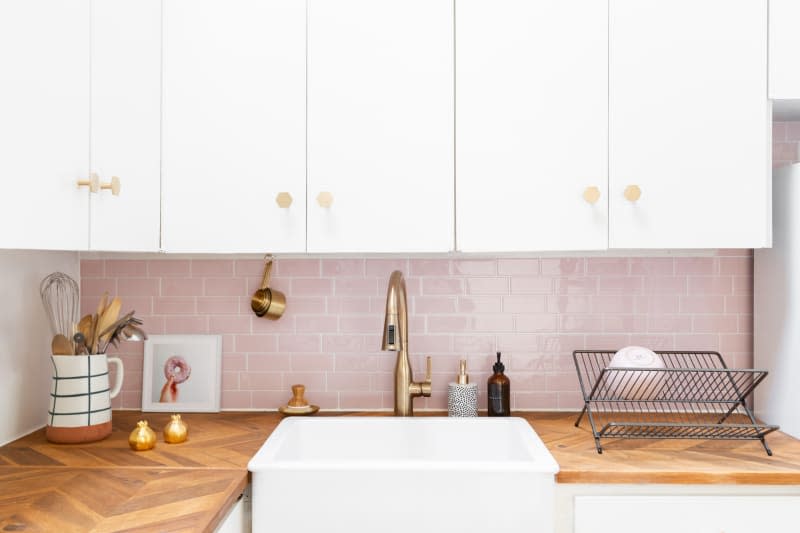10 Things Pro Cleaners Wish You Wouldn't Do to Your Kitchen Cabinets

Your cabinets are, in many ways, the epicenter of your kitchen. So it makes sense you’d want to keep them looking clean. The problem is, cabinets are often prone to pesky splatters (not to mention all that greasy film that accumulates on the ones surrounding your stove). Finding effective methods for cleaning your cabinets — and creating a routine you can stay on top of — is the best way to keep your cabinetry in tip-top shape over time.
But just like any type of cleaning, it’s also important to avoid certain mistakes (lest you end up with a bigger mess or, worse, irreversible damage!). Before you clean your cabinets, be sure to review these 10 all-too-common mistakes professional cleaners want you to avoid.
1. Overloading cleaning cloths
If you have wooden cabinets, a sopping-wet cleaning cloth can cause them to warp, and if excess water reaches the joints, the cabinet structure could be compromised. “Wring out your cleaning cloth before you clean these cabinets to avoid excess moisture,” suggests Will Cotter, COO of residential cleaning company FreshSpace.
2. Excessive scrubbing
Similarly, scrubbing vigorously can harm cabinet finishes, chipping paint or damaging wood. Cotter recommends using a gentle, circular motion when you’re attempting to work out tough spots and stains on cabinet doors.
3. Cleaning with harsh chemicals
Strong chemicals like bleach, ammonia, or strong solvents are no match for kitchen cabinets, says Kevin Gieck, manager at deep-cleaning company Bio Recovery. These can easily damage cabinet finishes, especially if they’re painted or have a glossy surface. Stick to mild, non-abrasive, and non-chemical cleaners (like this one).
4. Neglecting the inside
Don’t forget to clean the inside of your cabinets every now and again, too. “They can accumulate crumbs and spills, which might attract pests or create unpleasant odors,” Gieck says.
5. Ignoring the finish type
Different cabinet materials and finishes require different cleaning methods. For example, Gieck says wood cabinets may need special care to prevent drying and cracking, while laminate cabinets are easier to clean but may not withstand excessive moisture.
6. Neglecting grease buildup
As we know, kitchen cabinets are prone to grease buildup, especially around the stove. To avoid unsightly cabinets, unwanted smells, or potential damage, Cotter suggests regularly cleaning cabinet film with a degreasing product or a mixture of warm water and baking soda.
7. Not using cabinet liners
Cabinet liners can protect the inside of your cabinets from hard-to-clean spills and stains. Plus, it’s way easier to clean a liner than it is an entire cabinet. Make things simple and line all your shelves and drawers.
8. Not testing a new product
As with any other area in your home, Gieck says it’s important to spot test a new cleaner on an inconspicuous area (like the inside of your cabinet door) to ensure it doesn’t harm the finish. If it doesn’t, carry on with your cleaning!
9. Not dusting before cleaning
It’s always a good idea to dust before you deep-clean, so you’re not just spreading around tiny debris. “Dusting or using a microfiber cloth to remove loose particles before cleaning cabinets is essential,” says Gieck.
10. Rushing the drying process
Next time you clean the inside of your cabinets, wipe them dry thoroughly and inspect for any moisture before you close the doors. Cotter says closing damp cabinets can trap moisture and cause damage (and musty smells).
The best way to clean cabinets
To clean kitchen cabinets effectively, Gieck recommends using a mild dish soap and warm water solution, vinegar and water, or a specialized cabinet cleaner. (We also found these were the winning strategies when we put different cabinet cleaning methods to the test!). “Regular, gentle cleaning is the key to keeping your kitchen cabinets looking great while avoiding common cleaning mistakes,” he says. Always follow the manufacturer’s recommendations for cleaning and maintenance, and be mindful of the specific material and finish of your cabinets when you clean.
This post originally appeared on The Kitchn. See it there: 10 Things Pro Cleaners Wish You Would Stop Doing to Your Kitchen Cabinets

